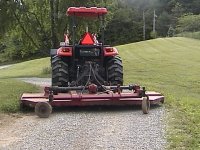Soundguy
Old Timer
- Joined
- Mar 11, 2002
- Messages
- 52,424
- Location
- Central florida
- Tractor
- RK 55HC,ym1700, NH7610S, Ford 8N, 2N, NAA, 660, 850 x2, 541, 950, 941D, 951, 2000, 3000, 4000, 4600, 5000, 740, IH 'C' 'H', CUB, John Deere 'B', allis 'G', case VAC
Reading your previous posts, it sure looked like you were saying that the mower was going to be more up than down. With this last post, it sounds like the mower is down 95% of the time, and then raised to maneuver around obstacles. That's 2 entirely different scenerieos, and was what I was refering to. It is probably easier to make the mower stable enough for intermittant pickups, vs running full up while being transported..
My ford 5000 easilly picks up my 10'mower weight wise, but I had to hand 420# on the front as it really unloads the front end. As it is now.. I feel 100% comfortable about mowing with it down, and also moving the tractor at mowing speeds with it raised up. I would not run it at transport speeds with it raised up unless I added another 300 pounds or so up front. My 7610s could transport it raised fine.. but is a tad heavier, plus has 640 pounds of weight up front. Those few hundred pounds make a difference in raising at mowing speed, and raising at trasnport speed... that's the point I was trying to make...
That is.. do you really need the extra ballast on the tractor ? it adds to soil compaction, fuel usage, and bearing loads. That's why i try to get away with a good safe counterballance, even if doubling the weight might get me another few percent safety, vs lower efficience int he pasture, damage to the pasture, and wear and tear on the tractor.
Soundguy
My ford 5000 easilly picks up my 10'mower weight wise, but I had to hand 420# on the front as it really unloads the front end. As it is now.. I feel 100% comfortable about mowing with it down, and also moving the tractor at mowing speeds with it raised up. I would not run it at transport speeds with it raised up unless I added another 300 pounds or so up front. My 7610s could transport it raised fine.. but is a tad heavier, plus has 640 pounds of weight up front. Those few hundred pounds make a difference in raising at mowing speed, and raising at trasnport speed... that's the point I was trying to make...
That is.. do you really need the extra ballast on the tractor ? it adds to soil compaction, fuel usage, and bearing loads. That's why i try to get away with a good safe counterballance, even if doubling the weight might get me another few percent safety, vs lower efficience int he pasture, damage to the pasture, and wear and tear on the tractor.
Soundguy
Farmwithjunk said:Not missing any point, entirely or not.
I'm weighting the tractor for carring the mower RAISED. My 3000 Ford could lug the mower around with the tailwheel ALWAYS on the ground. I'm not running around on a square, flat field. Most of the TIME SPENT mowing for me is cleaning up around the edges of a woods, a creek bank, and a couple hillsides. While I'm on those hills, I have to turn around in a couple rocky areas. That DEMANDS raising the mower and it's tailwheel off the ground. I'm cutting around rock edges of a creek bank. I HAVE to hold the weight of the mower off the ground because sometimes the tailwheel is 8 or 10' in the air when sticking over the bank.
In short, I'm not mowing the same way you are., I have to set up things so they're safe and able to get a job done.
The BB840, with chain gaurds front and back, along with double tail wheels
is a tad over 1500 lbs. The tractor EASILY handle 2500 lb loads on the hitch. NOT when backing over banks, turning on steep hillsides with the mower raised, or a great deal of the mowing it has to do. At least not 100% safe, 100% of the time.
The 2440 weighs in at 7400lbs, weights, fluid, ROPS, ect incl. It isn't overloaded, not even close. (Cousin had a 2440 too. He ran a 10' 3-point mower (on more reasonably "flat ground"))


